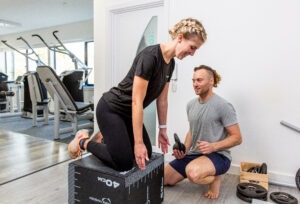In the field of fitness and rehabilitation, innovative training methods are continuously emerging to optimise gains and expedite recovery. One such method gaining prominence is Blood Flow Restriction (BFR) training. Initially developed as a medical intervention, BFR training has transcended its origins to become a versatile tool for athletes, fitness enthusiasts, and rehabilitation professionals alike. At Tops:Health, we are continuously striving to optimise our client’s recovery and wellness with new innovative evidence-based methods of rehabilitation, such as BFR training. This blog aims to shed light on the mechanism behind BFR training and explore its numerous health and rehabilitative benefits.
Understanding Blood Flow Restriction:
Blood Flow Restriction (BFR) training involves the application of a specialised cuff around the proximal portion of a limb, typically the upper arm or thigh. The cuff is tightened to partially restrict blood flow to the working muscles while allowing arterial blood to enter the limb and minimising venous return. This results in a temporary reduction in oxygen supply and a buildup of metabolites within the muscle tissue.
Mechanism of Action: The essence of BFR training lies in its ability to create a unique physiological environment within the working muscles. The restriction of blood flow initiates a cascade of responses that contribute to muscle growth, strength gains, and even cardiovascular improvements. Some of the key mechanisms include:
- Metabolic Stress: The restricted blood flow leads to the accumulation of metabolic byproducts, such as lactate and hydrogen ions within the muscle tissue. This heightened cellular stress triggers the release of growth factors and hormones that stimulate muscle growth and repair. This also triggers the nervous system to recruit more muscle fibers to meet the demand for energy production. This phenomenon is referred to as the “metabolic stress reflex.” As a result, more muscle fibers are engaged during BFR training, leading to greater muscle activation.
- Cellular Swelling: BFR training causes an accumulation of fluid within the muscle cells, a phenomenon known as cellular swelling. This swelling creates mechanical tension within the muscle fibers, further stimulating muscle activation. The mechanical stress caused by cellular swelling, in combination with the metabolic stress from reduced blood flow, contributes to increased motor unit recruitment and muscle growth
- Fast-Twitch Fiber Recruitment: BFR training encourages the recruitment of fast-twitch muscle fibers, which have a higher potential for growth and greater force-generating capacity. Research suggests that the reduced oxygen supply caused by BFR leads to the early recruitment of these fast-twitch fibers, even at low training intensities A study in the “European Journal of Applied Physiology” (Kacin and Strazar, 2011) revealed that BFR training led to significant activation of fast-twitch fibers even at low loads. Since fast-twitch fibers generate more force compared to slow-twitch fibers, their recruitment contributes to increased muscle activation during BFR training. Therefore, this recruitment pattern contributes to the hypertrophic (muscle growth) response that has been observed with BFR.
- Neural adaptations: BFR prompts the nervous system to adapt by recruiting a larger number of motor units, which consist of a motor neuron and the muscle fibers it innervates. Over time, these neural adaptations result in improved motor unit synchronization and increased motor unit recruitment. This enhanced neural drive leads to greater muscle activation during BFR training and, subsequently, during other forms of exercise as well.
- Hormonal Response: The localised hypoxia, which is the limited oxygen supply, and stress from BFR training prompt the release of anabolic hormones like growth hormone and insulin-like growth factor-1 (IGF-1), further supporting muscle development and growth.
- Increased Muscle Activation: With reduced blood flow, muscles must work harder to overcome the challenge, leading to enhanced neural recruitment and improved muscle activation.
Benefits of Blood Flow Restriction Training:
Muscle Hypertrophy: BFR training has been shown to elicit muscle growth similar to that achieved with heavy resistance training, even when using significantly lighter weights. This makes it an appealing option for individuals who cannot handle heavy loads due to injury or other limitations.
Strength Gains: Despite using light resistance, BFR training can significantly enhance strength, making it an effective option for those in rehabilitation or needing to reduce joint stress in a safe manner.
Efficient Workouts: BFR training allows for shorter training sessions with equivalent or even superior results compared to traditional training methods. This efficiency is particularly beneficial for busy individuals seeking time-effective workouts.
Injury Rehabilitation: BFR training aids in post-injury recovery by facilitating muscle activation and growth without placing excessive strain on injured tissues.
Cardiovascular Benefits: BFR training triggers improvements in endothelial function and increases in vascular responsiveness, contributing to overall cardiovascular health.
Aging and Sarcopenia: Aging often brings about changes in muscle mass and function, leading to a condition called sarcopenia. Sarcopenia is characterized by a gradual decline in muscle mass, strength, and overall physical performance. Blood Flow Restriction (BFR) training has emerged as a potential strategy to counteract the effects of aging and mitigate the progression of sarcopenia BFR training holds promise in combating age-related muscle loss and improving functional capacity in older adults.
Reduction of Joint Stress: BFR training’s utilization of lower loads reduces joint stress while still inducing muscle adaptations. A study in the “Journal of Strength and Conditioning Research” (Clarkson et al., 2020) noted that BFR training can provide a safer alternative for individuals with joint concerns.
Conclusion:
Blood Flow Restriction training, once a niche medical intervention, has emerged as a versatile tool for enhancing muscle growth, strength, and recovery. By capitalising on its unique physiological responses, BFR training offers an innovative approach that benefits a wide range of individuals, from athletes aiming to amplify their gains and recovery to individuals seeking effective rehabilitation methods. As research in this field continues to evolve, BFR training’s potential applications are likely to expand, solidifying its place as a valuable addition to the fitness and rehabilitation which we at Tops:health are aiming to achieve.
References:
Clarkson, M. J., Conway, J., Raabe, J., Behm, D. G., Triplett, T. N., & Sato, Y. (2020). Acute impact of BFR resistance exercise on joint range of motion. Journal of Strength and Conditioning Research, 34(2), 419-427.
Laurentino, G. C., Ugrinowitsch, C., Aihara, A. Y., Fernandes, A. R. C., Parcell, A. C., Ricard, M., … & Tricoli, V. A. A. (2012). Effects of strength training and vascular occlusion. International Journal of Sports Medicine, 33(05), 381-387.
Laurentino, G. C., Ugrinowitsch, C., Aihara, A. Y., Fernandes, A. R. C., Parcell, A. C., Ricard, M., … & Tricoli, V. A. A. (2012). Effects of strength training and vascular occlusion. International Journal of Sports Medicine, 33(05), 381-387.



